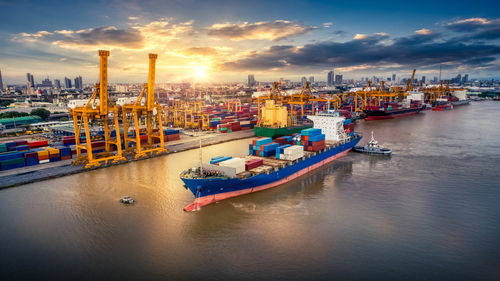Trading places: How we are producing consistent estimates of trade figures following the UK’s EU exit

As well as changing our trading relationships with the European Union, the departure of the United Kingdom from the EU has changed the way that trade in goods is recorded. The continuity of the UK’s international trade figures has therefore also been affected. In this post Hannah Donnarumma summarises recent changes and how the ONS is responding to their impact on our headline statistics.
When the UK was a member of the EU and the Single Market our trade in goods with the rest of the EU was estimated primarily using the Intrastat Survey. This was completed by VAT registered UK businesses that imported or exported goods, but some small traders, non-VAT registered businesses and parcel post were excluded.
From January 2021, when the UK’s transition period ended, data collected on goods exports from Great Britain (GB) to the EU moved from the Intrastat Survey to HMRC customs declarations. This was followed a year later, in January 2022, by data on GB imports from the EU moving to customs declarations. It is worth noting that Northern Irish trade with the EU remains on the Intrastat Survey.
While broadly consistent, the inclusion of parcel post, smaller traders and non-VAT registered businesses in the new collection method led to an increase in the value of goods exports to the EU in 2021, and then an increase in value of goods imports in 2022. We have since adjusted our EU import figures for 2021, so that trade balances are consistent. However, there is still a discontinuity in our export and imports figures between 2020 and 2021. We are currently looking closely at whether further adjustments can be made to the back series to create a more consistent historical series.
In addition, when the requirement for customs declaration was introduced for imports to GB from the EU in January 2021, a new policy of Staged Customs Controls was implemented. This allowed importers to delay their customs declarations up to 175 days from the date the goods entered the country in 2021. It is possible that some double counting of goods imports from the EU occurred as a result; with imports in the second half of 2021 recorded via the Intrastat Survey, then some appearing again on customs declarations in the first half of 2022.
EU imports rose sharply at the start of 2022, and then fell somewhat in the middle of 2022, which would suggest an element of double counting. However, they have again risen strongly in recent months, so it is difficult to estimate to what extent double counting may have occurred. We continue to work closely with colleagues at HMRC, analysing trends at a product level, to estimate if further adjustments are needed.
Given the changes in collection methods, one approach might be to align our data with that of Eurostat. However, following divergence in the first half of 2022 between Eurostat and ONS measures, there has been further divergence in recent months despite the Staged Customs Controls period having formally ended. As such, caution is needed when interpreting these data sources. Eurostat data, although a useful reference, should not be considered an authoritative depiction of trade with the EU. Even before the UK left the EU, the UK data never completely aligned with Eurostat estimates, making comparisons challenging. We and HMRC are working together to understand differences in data collection and methods that might explain this lack of alignment.
Throughout the last two years we have kept users up to date about these changes in collection methods and, where possible, estimated the impact of these various changes on our headline estimates. We will continue to work hard at identifying discontinuities, and, where warranted, adjust our figures to ensure we can continue to produce high quality estimates of these important statistics. It should be noted that any future adjustments to trade statistics would very likely have no or only very limited impact on GDP estimates.
We are currently analysing recent patterns between UK and Eurostat trade data at a product and country level, and will be publishing more information about these in the coming weeks.

Hannah Donnrumma is Co-Head of Trade and Tourism Statistics at the Office for National Statistics